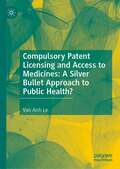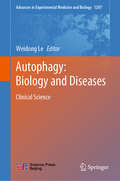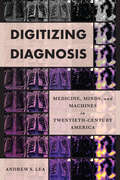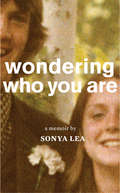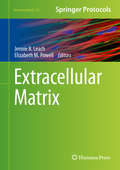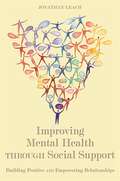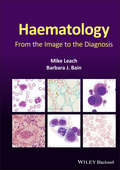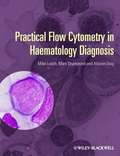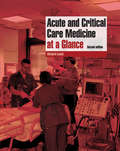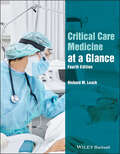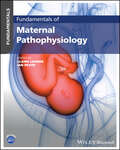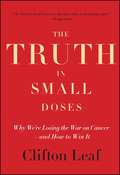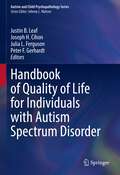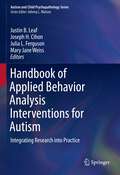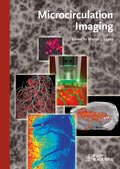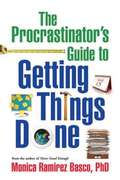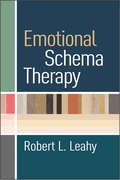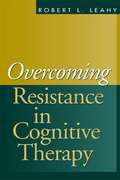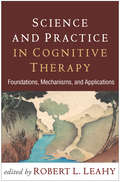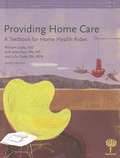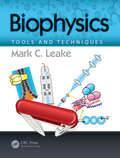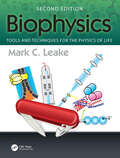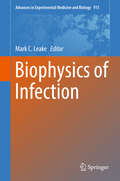- Table View
- List View
The NeuroGeneration: The New Era in Brain Enhancement That Is Revolutionizing the Way We Think, Work, and Heal
by Tan LeBrain science is at the dawn of a new era—and the technologies emerging as a result could forever alter what it means to be human. Welcome to what tech pioneer and inventor Tan Le calls "the NeuroGeneration." It will blow your mind. The human brain is perhaps the most powerful and mysterious arrangement of matter in the known universe. New discoveries that unravel this mystery and let us tap into this power offer almost limitless potential—the ability to reshape ourselves and our thought processes, to improve our health and extend our lives, and to enhance and augment the ways we interact with the world around us. It may sound like the stuff of science fiction, but it is quickly becoming reality. In The NeuroGeneration, award-winning inventor Tan Le explores exciting advancements in brain science and neurotechnology that are revolutionizing the way we think, work, and heal. Join Le as she criss-crosses the globe, introducing the brilliant neurotech innovators and neuroscientists at the frontiers of brain enhancement. Along the way, she shares incredible stories from individuals whose lives are already being transformed by their inventions—an endurance racer paralyzed in a fall, who now walks thanks to neural stimulation and an exoskeleton; a man who drives a race car with his mind; even a color-blind "cyborg" whose brain implant allows him to "hear" colors. The NeuroGeneration reveals the dizzying array of emerging technologies—including cranial stimulation that makes you learn faster, an artificial hippocampus that restores lost memories, and neural implants that aim to help us keep up with or even outpace artificial intelligence—that promise to alter the brain in unprecedented ways, unlocking human potential we never dreamed possible. Le also explores how these futuristic innovations will impact our world, disrupt the way we do business, upend healthcare as we know it, and remake our lives in wondrous and unexpected ways. As fascinating as it is timely, The NeuroGeneration offers a thrilling glimpse of the future of our species, and how changing our brains can change human life as we know it.
Compulsory Patent Licensing and Access to Medicines: A Silver Bullet Approach to Public Health?
by Van Anh LeThis timely monograph focuses on India and Brazil’s use of compulsory licensing, one of the most significant and controversial TRIPS flexibilities. This is a topical work at this critical time when the COVID-19 has stirred up the debate about compulsory licensing and access to medicines. A closer look into the historical use of compulsory licences in certain countries can offer some takeaways for the current situation.The author studies historical developments and political conditions of the patent system and compulsory licensing from the earliest stage to the modern arena, with a great emphasis on TRIPS. After conducting a cross-national study of India and Brazil, the book moves on to evaluate the different philosophies on compulsory licensing of multilateral organizations such as the EU, the WIPO, the WTO, and NGOs.This important book will strongly appeal to intellectual property students, academics, policymakers, and lawyers practicing in the area. It will also be of interest to academics working in the areas of international law, development, and public health as well as state actors and others with relevant concerns working in multilateral organizations.
Autophagy: Clinical Science (Advances in Experimental Medicine and Biology #1207)
by Weidong LeThis book consists of 3 volumes: Basic Science (Volume 1), Clinical Science (Volume 2) and Technology and Methodology (Volume 3). Volume 2 focuses on the clinical aspects of autophagy research, discussing the role of autophagy in neuropsychiatric disorders, the cardiovascular, immune, digestive and endocrine systems, as well as tumors, infection, the kidney, and the respiratory and hematological systems. It also addresses autophagy-related drug development. Written and edited by a team of 90 experts, and presenting the state of the art in autophagy research, this book is a valuable reference resource for researchers and clinicians alike. It can also be used as supplementary material for graduate students majoring in biology and medicine
Digitizing Diagnosis: Medicine, Minds, And Machines In Twentieth-century America (Studies In Computing And Culture Ser.)
by Andrew S. LeaWondering Who You Are: A Memoir
by Sonya LeaIn exploring her husband's traumatic brain injury and loss of memory, Sonya Lea has written a memoir that is both a powerful look at perseverance in the face of trauma and a surprising exploration into what lies beyond our fragile identities. In the twenty-third year of their marriage, Sonya Lea's husband, Richard, went in for surgery to treat a rare appendix cancer. When he came out, he had no recollection of their life together: how they met, their wedding day, the births of their two children. All of it was gone, along with the rockier parts of their past--her drinking, his anger. Richard could now hardly speak, emote, or create memories from moment to moment. Who he'd been no longer was. Wondering Who You Are braids the story of Sonya and Richard's relationship, those memories that he could no longer conjure, together with his fateful days in the hospital--the internal bleeding, the near-death experience, and eventual traumatic brain injury. It follows the couple through his recovery as they struggle with his treatment, and through a marriage no longer grounded on decades of shared experience. As they build a fresh life together, as Richard develops a new personality, Sonya is forced to question her own assumptions, beliefs, and desires, her place in the marriage and her way of being in the world. With radical candor and honesty, Sonya Lea has written a memoir that is both a powerful look at perseverance in the face of trauma and a surprising exploration into what lies beyond our fragile identities.
Extracellular Matrix
by Jennie B. Leach Elizabeth M. PowellThis volume provides comprehensive procedures for analyzing the extracellular matrix in native, injured, and engineered neural tissues. Divided into four parts, each focusing on different aspects of the extracellular matrix and the nervous system, Extracellular Matrix covers methods to analyze native tissue, in vitro models for investigating cell-extracellular matrix interactions in a variety of contexts, protocols to investigate the role of the extracellular matrix in nervous system injury, degeneration, and regeneration, as well as therapeutics and engineered systems. Each chapter is written by leading experts and presents established protocols in a concise format, encompassing current technologies as well as methods developed over years of research. Beginning with an introduction to the method, chapters continue with a listing of the materials and equipment, step-by-step protocols, and a Notes section with troubleshooting tips, supplemental details and alternative approaches, as well as a list of references for further information. As part of the practical and convenient Neuromethods series, Extracellular Matrix serves as an invaluable aid for researchers studying this vital area of neuroscience.
Improving Mental Health through Social Support: Building Positive and Empowering Relationships
by Jonathan LeachSocial support is the everyday assistance offered by family, friends, neighbours and colleagues, as well as the foundations of support in a range of non-clinical settings, and plays a vital role in a person's mental health and wellbeing. This book examines the nature of social support and offers a practical approach to how it can be enhanced. Focusing on the relationships between service users and supporters , it examines service users' experiences of issues of identity, stigma, social exclusion and social networks. Individual chapters look in depth at how social support is enacted in close relationships, educational institutions and in the world of employment. The nature of 'community' is explored with particular reference to how service users can be supported into greater engagement with social networks. Demonstrating the importance of social perspectives on mental health, this book is essential reading for practitioners, students and educators in mental health, social and community work, community mental health nursing and occupational therapy.
Haematology: From the Image to the Diagnosis
by Mike Leach Barbara J. BainHaematology Diagnostic haematology requires the assessment of clinical and laboratory data together with a careful morphological assessment of cells in blood, bone marrow and tissue fluids. Subsequent investigations including flow cytometry, immunohistochemistry, cytogenetics and molecular studies are guided by the original morphological findings. These targeted investigations help generate a prompt unifying diagnosis. Haematology: From the Image to the Diagnosis presents a series of cases illustrating how skills in morphology can guide the investigative process. In this book, the authors capture a series of images to illustrate key features to recognize when undertaking a morphological review and show how they can be integrated with supplementary information to reach a final diagnosis. Using a novel format of visual case studies, this text mimics ‘real life’ for the practising diagnostic haematologist – using brief clinical details and initial microscopic morphological triage to formulate a differential diagnosis and a plan for efficient and economical confirmatory investigation to deduce the correct final diagnosis. The carefully selected, high-quality photomicrographs and the clear, succinct descriptions of key features, investigations and results will help haematologists, clinical scientists, haematology trainees and haematopathologists to make accurate diagnoses in their day-to-day work. Covering a wide range of topics, and including paediatric as well as adult cases, Haematology: From the Image to the Diagnosis is a succinct visual guide which will be welcomed by consultants, trainees and scientists alike.
Practical Flow Cytometry in Haematology Diagnosis
by Mike Leach Mark Drummond Allyson DoigThis book acts as a clinical manual for the diagnostician who cannot turn to reference books when the morphology or immunophenotype are atypical. This volume presents a logical practical approach to the diagnosis of blood disorders, both neoplastic and reactive, and other diagnostic applications of flow cytometry in non-neoplastic haematology diagnosis. Illustrations are provided throughout with worked examples.
Acute and Critical Care Medicine at a Glance
by Richard M. LeachThe at a Glance series is popular among medical students and junior doctors for its concise and simple approach and excellent illustrations.Each bite-sized chapter is covered in a double-page spread with colour summary diagrams on the left page and explanatory text on the right. Covering a wide range of topics, books in the at a Glance series are ideal as introductory subject texts or for revision purposes, and are useful throughout medical school and beyond.Everything you need to know about Acute and Critical Care Medicine...at a Glance!Following the familiar, easy-to-use at a Glance format, and now in full-colour, Acute and Critical Care Medicine at a Glance is an accessible introduction and revision text for medical students. Fully revised and updated to reflect changes to the content and assessment methods used by medical schools, this at a Glance provides a user-friendly overview of Acute and Critical Care Medicine to encapsulate all that the student needs to know.This new edition of Acute and Critical Care Medicine at a Glance:Provides a brief and straightforward, yet rapid, introduction to care of the critically ill that can be easily assimilated prior to starting a new job or clinical attachmentEncompasses the clinical, diagnostic and therapeutic skills required to manage acutely ill patients in a variety of settingsIncludes assessment of the acutely unwell patient, monitoring, emergency resuscitation, oxygenation, circulatory support, methods of ventilation and management of a wide variety of medical and surgical emergenciesIncludes new chapters on fluid management, oxygenation, non-invasive ventilation, recognition of the seriously ill patient and hospital-acquired infectionsThis book is an invaluable resource for all undergraduates in medicine, as well as clinical medical students, junior doctors, nurses caring for acutely-ill patients and paramedics.Pre-publication reviews:"The material forms an excellent basis for junior doctors in critical care and anaesthesia to get a good grounding in the subject, without appearing too scary."-Senior House Officer"The system-based approach...provides excellent reference material when studying a particular subject, allowing the reader to easily delve into the book when necessary, without having to read from cover-to-cover. It is an excellent revision aid.... Much time has gone into eliminating superfluous data so maximal essential information can be conveyed quickly."-UCL student
Critical Care Medicine at a Glance (At a Glance)
by Richard M. LeachCritical Care Medicine at a Glance The market-leading at a Glance series is popular among healthcare students and newly qualified practitioners for its concise, simple approach and excellent illustrations. Each bite-sized chapter is covered in a double-page spread with clear, easy-to-follow diagrams, supported by succinct explanatory text. Covering a wide range of topics, books in the at a Glance series are ideal as introductory texts for teaching, learning and revision, and are useful throughout university and beyond. Everything you need to know about Critical Care Medicine… at a Glance! Critical Care Medicine at a Glance, Fourth Edition provides a succinct, accessible, highly illustrated introduction to the care of the critically ill patient. Designed for medical students, junior doctors and nurses alike, this authoritative revision guide covers the essential clinical, diagnostic, and therapeutic skills required to manage critically ill patients with a wide range of conditions in a variety of settings. Colour-coded chapters which contain concise explanatory text, applications to practice, and numerous high-quality photographs, illustrations, diagrams and tables. Fully revised to reflect current guidelines, changes in practice and recent medical innovations, this fourth edition includes expanded coverage of resus, sepsis, COVID-19, ECMO, dermatological emergencies, envenomation and other key conditions and procedures. Updated chapters incorporate current assessment methods used by medical schools and postgraduate training programmes, whilst additional ‘Pearls of Wisdom’ boxes and ‘Wise Owl Reading’ reference suggestions are integrated throughout to aid learning and comprehension. Allows rapid access to the knowledge and skills required to care for the acute and critically ill Covers a wide range of topics such as respiratory and neurological emergencies, arrhythmias, ventilation and intubation, trauma surgery and abdominal imaging Features contributions from leading critical care practitioners Provides normal values, reference ranges and treatment and monitoring guidelines for various critical care scenarios Includes practical case studies, revision questions and self-assessment tests with answers Contains several useful appendices, including information on pacemaker types and classifications Critical Care Medicine at a Glance, Fourth Edition is a must-have for medical students, junior doctors and nurses in intensive care and emergency medicine and those undertaking postgraduate exams. For more information on the complete range of Wiley Medical Education publications, please visit: www.wiley.com To receive automatic updates on Wiley books and journals, join our email list. Sign up today at www.wiley.com/email All content reviewed by students for students Wiley Medical Education books are designed exactly for their intended audience. All of our books are developed in collaboration with students. This means that our books are always published with you, the student, in mind. If you would like to be one of our student reviewers, go to www.reviewmedicalbooks.com to find out more. This book is also available as an e-book. For more details, please see www.wiley.com/buy/9781119605881
Nanotoxicology in Humans and the Environment (Molecular and Integrative Toxicology)
by Jamie R. Lead Shareen H. Doak Martin J. D. CliftThe book covers the area of ‘Nanotoxicology’ but primarily from the point of view of nanotoxicology at the interface with other disciplines including human toxicology; environmental toxicology; characterization, dose and transformations; regulation; public and elite group perceptions; and interactions with innovation.Nanotoxicology in Humans and the Environment is written for researchers in nanotoxicology in academia, industry, government, and research students. Given the rapid development, the maturing of the discipline and its importance in current regulation and industry development (eg REACH, TSCA), the book is very timely.
Fundamentals of Maternal Pathophysiology (Fundamentals)
by Claire Leader Ian PeateFundamentals of Maternal Pathophysiology An introduction to pathophysiology specifically tailored to the needs of midwives Professional standards of proficiency require that midwives develop a robust understanding of pathophysiology, the study of disordered physical processes including disease and injury. This dedicated text equips both aspiring and registered midwives with the foundational understanding of pathophysiology required to deliver the best patient care. An understanding of pathophysiology is paramount for the delivery of safe and effective care during the various stages of pregnancy, childbirth and postpartum recovery. This understanding provides midwives with the insight to recognise and respond promptly to complications, fostering optimal outcomes for the mother and the newborn. Early recognition is pivotal, allowing for timely interventions that can significantly influence maternal and fetal well-being. A holistic approach to care is the cornerstone of midwifery and an understanding of pathophysiology allows midwives to consider the physical, emotional and social aspects of a woman’s health. This holistic perspective contributes to a more comprehensive and person-centred model of care. This user-friendly introduction is not only a foundational text but also a practical resource for practicing midwives. Informed by the latest research and reflective of current best practices, this book stands as an indispensable tool for this indispensable profession. Tailored for both undergraduate and graduate midwifery students, as well as registered midwives returning to practice, this resource is an invaluable asset in advancing pathophysiological knowledge within midwifery practice.
The Truth in Small Doses
by Clifton LeafA provocative, eye-opening history of the war on cancer, The Truth in Small Doses asks why we are losing this essential fight and charts a path forward. OVER THE PAST HALF CENTURY, deaths from heart disease, stroke, and so many other killers have fallen dramatically. But cancer continues to kill with abandon. In 2013, despite a four-decade "war" against the disease that has cost hundreds of billions of dollars, more than 1.6 million Americans will be diagnosed with cancer and nearly six hundred thousand will die from it. A decade ago, Clifton Leaf, a celebrated journalist and a cancer survivor himself, began to investigate why we had made such limited progress fighting this terrifying disease. The result is a gripping narrative that reveals why the public's immense investment in research has been badly misspent, why scientists seldom collaborate and share their data, why new drugs are so expensive yet routinely fail, and why our best hope for progress--brilliant young scientists-- are now abandoning the search for a cure. The Truth in Small Doses is that rare tale that will both outrage readers and inspire conversation and change.
Handbook of Quality of Life for Individuals with Autism Spectrum Disorder (Autism and Child Psychopathology Series)
by Justin B. Leaf Joseph H. Cihon Julia L. Ferguson Peter F. GerhardtThis handbook offers a comprehensive examination of wide-ranging issues relevant to adults diagnosed with autism spectrum disorder. Coverage includes a detailed review of such issues as psychiatric comorbidity, family relationships, education, living in different settings (e.g., group homes, community), meaningful and effective interventions, functional goals (e.g., social, language, vocational, and adaptive behaviors), and curriculum. In addition the book provides unique perspectives of parents as well as individuals diagnosed with autism spectrum disorder who have reached adulthood.Key areas of coverage include: Transitioning adults diagnosed with autism spectrum disorder from educational settings to vocational settings. Strategies that can help create independence for adults diagnosed with autism spectrum disorder. Effective approaches to address issues relating to sexuality for adults diagnosed with autism spectrum disorder. The effectiveness of early intensive behavioral intervention to help adults diagnosed with autism spectrum disorder. Handbook of Quality of Life for Individuals with Autism Spectrum Disorder is an essential reference for researchers, professors, and graduate students as well as clinicians, therapists, and related professionals in clinical child and school psychology, social work, behavioral therapy and related disciplines, including clinical medicine, clinical nursing, counseling, speech and language pathology, and special education.
Handbook of Applied Behavior Analysis Interventions for Autism: Integrating Research into Practice (Autism and Child Psychopathology Series)
by Justin B. Leaf Mary Jane Weiss Joseph H. Cihon Julia L. FergusonThis handbook addresses evidence-based practices in Applied Behavior Analysis (ABA) for individuals diagnosed with autism spectrum disorder (ASD). It provides an overview of the history of evidence-based practices and their importance as applied to the law, school settings, and factors that influence the use for treatment of ASD. Additional areas of coverage include evidence-based and non-evidence-based ABA interventions for autism as well as decision-making ethics related to these treatments. In addition, the book addresses cultural considerations as they relate to these treatments and examines procedural aspects of ABA interventions for autism. Key ABA treatments addressed include: Discrete trial teaching. Pivotal response training. Video modeling. Parent-mediated intervention. Early Start Denver Model, PEAK, PECS, and AAC. Script fading/activity schedules and differential reinforcement/extinction. Response interruption and redirection. Self-management and self-monitoring. The Handbook of Applied Behavior Analysis Interventions for Autism is a must-have resource for researchers, professors, and graduate students as well as clinicians, therapists, and other professionals across such interrelated disciplines as clinical child, school, and developmental psychology, child and adolescent psychiatry, social work, rehabilitation medicine/therapy, pediatrics, and special education.
Microcirculation Imaging
by Martin J. LeahyAdopting a multidisciplinary approach with input from physicists, researchers and medical professionals, this is the first book to introduce many different technical approaches for the visualization of microcirculation, including laser Doppler and laser speckle, optical coherence tomography and photo-acoustic tomography. It covers everything from basic research to medical applications, providing the technical details while also outlining the respective strengths and weaknesses of each imaging technique. Edited by an international team of top experts, this is the ultimate handbook for every clinician and researcher relying on microcirculation imaging.
Procrastinator's Guide to Getting Things Done
by Robert Leahy Monica BascoEveryone waits till the last minute sometimes. But many procrastinators pay a significant price, from poor job performance to stress, financial problems, and relationship conflicts. Fortunately, just as anyone can endlessly delay, anyone can learn how to stop! Cognitive-behavioral therapy expert Monica Ramirez Basco shows exactly how in this motivating guide. Dr. Basco peppers the book with easy-to-relate-to examples from "recovering procrastinators"--including herself. Inviting quizzes, exercises, and practical suggestions help you Understand why you procrastinate. Start with small changes that lead to big improvements. Outsmart your own delaying tactics. Counteract self-doubt and perfectionism. Build crucial skills for getting things done today.
Emotional Schema Therapy
by Robert L. LeahyOver decades of practice of cognitive-behavioral therapy (CBT), Robert L. Leahy has made important discoveries about the role that beliefs and expectations about emotions play in psychopathology. This book presents innovative tools for helping patients to understand their emotional schemas--such as the conviction that painful feelings are unbearable, shameful, or will last indefinitely--and develop new ways of accepting and coping with affective experience. Therapists can integrate emotional schema therapy into the treatment approaches they already use to add a vital new dimension to their work. Rich case material illustrates applications for a wide range of clinical problems; assessment guidelines and sample worksheets and forms further enhance the book's utility.
Overcoming Resistance in Cognitive Therapy
by Robert L. LeahyDespite the efforts of therapists and patients, many patients in cognitive-behavioral therapy or any therapy do not improve. This unique book is designed to help the clinician better understand and work with patients who seem unable or unwilling to make needed changes. Integrating ideas from a range of psychotherapeutic approaches, the book presents a multidimensional model of resistance. It enumerates the specific impediments to change that may arise in the cognitive therapy context and brings each one to life with realistic clinical illustrations. Clinicians learn practical strategies and interventions to deal with a number of types of resistance, from reluctance to comply with basic cognitive procedures to risk-aversion and self-handicapping. Also addressed are countertransference issues, including workable ways that clinicians can modify their own responses to patients to overcome impasses in treatment.
Science and Practice in Cognitive Therapy: Foundations, Mechanisms, and Applications
by Robert L. LeahyFrom leading experts in cognitive-behavioral therapy (CBT)--including CBT originator Aaron T. Beck and many who have worked closely with him--this book provides an overview of where the field is today and presents cutting-edge research and clinical applications. Contributors explain how Beck's cognitive model has been refined and tested over the last 45 years and describe innovative CBT approaches that integrate mindfulness, imagery, emotion-focused interventions, and other strategies. Chapters on specific clinical problems cover the conceptualization and treatment of depression, anxiety disorders, posttraumatic stress disorder, obsessive–compulsive disorder, insomnia, suicidality, substance abuse, couple and family problems, bipolar disorder, psychosis, and personality disorders.
Providing Home Care: A Textbook for Home Health Aides (4th Edition)
by William Leahy Jetta Fuzy Julie GrafeThe book presents content that reflects state and federal training requirements, OSHA regulations, and current CDC guidelines and "Green" material that discusses ways to be environmentally friendly.
Biophysics: Tools and Techniques
by Mark C. LeakeAn Up-to-Date Toolbox for Probing Biology Biophysics: Tools and Techniques covers the experimental and theoretical tools and techniques of biophysics. It addresses the purpose, science, and application of all physical science instrumentation and analysis methods used in current research labs. The book first presents the historical background, concepts, and motivation for using a physical science toolbox to understand biology. It then familiarizes undergraduate students from the physical sciences with essential biological knowledge. The text subsequently focuses on experimental biophysical techniques that primarily detect biological components or measure/control biological forces. The author describes the science and application of key tools used in imaging, detection, general quantitation, and biomolecular interaction studies, which span multiple length and time scales of biological processes both in the test tube and in the living organism. Moving on to theoretical biophysics tools, the book presents computational and analytical mathematical methods for tackling challenging biological questions including exam-style questions at the end of each chapter as well as step-by-step solved exercises. It concludes with a discussion of the future of this exciting field. Future innovators will need to be trained in multidisciplinary science to be successful in industry, academia, and government support agencies. Addressing this challenge, this textbook educates future leaders on the development and application of novel physical science approaches to solve complex problems linked to biological questions. Features: Provides the full, modern physical science toolbox of experimental and analytical techniques, such as bulk ensemble methods, single-molecule tools, and live-cell and test tube methods Incorporates worked examples for the most popular physical science tools, including full diagrams and a summary of the science involved in the application of the tool Reinforces the understanding of key concepts and biological questions A solutions manual is available upon qualifying course adoption.
Biophysics: Tools and Techniques for the Physics of Life
by Mark C. LeakeBiophysics: Tools and Techniques for the Physics of Life covers the experimental, theoretical, and computational tools and techniques of biophysics. It addresses the purpose, science, and application of all physical science instrumentation, theoretical analysis, and biophysical computational methods used in current research labs. The book first presents the historical background, concepts, and motivation for using a physical science toolbox to understand biology. It then familiarizes undergraduate students from the physical sciences with essential biological knowledge. The text subsequently focuses on experimental biophysical techniques that primarily detect biological components or measure/control biological forces. The author describes the science and application of key tools used in imaging, detection, general quantitation, and biomolecular interaction studies, which span multiple length and time scales of biological processes both in the test tube and in the living organism. Moving on to theoretical and computational biophysics tools, the book presents analytical mathematical methods and numerical simulation approaches for tackling challenging biological questions including exam-style questions at the end of each chapter as well as step-by-step solved exercises. It concludes with a discussion of the future of this exciting field. Future innovators will need to be trained in multidisciplinary science to be successful in industry, academia, and government support agencies. Addressing this challenge, this textbook educates future leaders on the development and application of novel physical science approaches to solve complex problems linked to biological questions. Features: Provides the full, modern physical science toolbox of experimental, theoretical, and computational techniques, such as bulk ensemble methods, single-molecule tools, live-cell and test tube methods, pencil-on-paper theory approaches, and simulations. Incorporates worked examples for the most popular physical science tools by providing full diagrams and a summary of the science involved in the application of the tool. Reinforces the understanding of key concepts and biological questions. A solutions manual is available upon qualifying course adoption.
Biophysics of Infection (Advances in Experimental Medicine and Biology #915)
by Mark C. LeakeThis book describes modern biophysical techniques that enable us to understand and examine dynamic processes of infection at the molecular level. Cutting-edge research articles, laboratory protocols, case studies and up-to-date reviews cover topics such as single-molecule observation of DNA replication repair pathways in E. coli; evolution of drug resistance in bacteria; restriction enzymes as barriers to horizontal gene transfer in Staphylococcus aureus; infectious and bacterial pathogen biofilms; killing infectious pathogens through DNA damage; bacterial surfaces in host-pathogen interactions; bacterial gene regulation by riboswitches; transcription regulation in enterobacterial pathogens; the bacterial flagellar motor; initial surface colonization by bacteria; Salmonella Typhi host restrictions; as well as monitoring proton motive force in bacteria; microbial pathogens using digital holography; mathematical modelling of microbial pathogen motility; neutron reflectivity in studying bacterial membranes; force spectroscopy in studying infection and 4D multi-photon imaging to investigate immune responses. The focus is on the development and application of complex techniques and protocols at the interface of life sciences and physics, which increase the physiological relevance of biophysical investigations.

